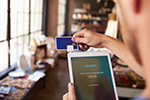Mobile platforms like Apple Pay and Samsung Pay let customers swipe their phone at an NFC-equipped terminal. Do you have one?
Mobile technology has altered the way consumers expect to pay, and businesses that aren't ready may get left out in the cold. Instead of them paying with cash or cards, mobile payment platforms, such as Apple Pay and Samsung Pay, let customers pay using their mobile phones at an NFC-equipped terminal. But it only works if you have the necessary hardware and software to accept that form of payment.
The technology is good for consumers because it gives them freedom to make purchases more quickly and securely than before. But it's a tricky proposition for retailers, since accepting mobile payments can mean making costly changes to your point-of-sale systems. It also means that you need to teach your staff how the technology works so they're able to assist customers that may be using a mobile wallet for the first time.
So, should your retail business make an investment in mobile payments? Here's what you need to know.
Understanding mobile payments
Mobile payments let customers pay even if they leave their wallets at home. Instead of checking out with cash or a credit card, they can hold their smartphones up to a wireless near-field communication (NFC) terminal to pay instantly.
It only works if the consumer has linked a mobile payment app on their phone to their credit card. And there's no need for the retailer to verify the expiration date or security code on the card – it's all stored on the customer's mobile device.
Consumers can use a variety of platforms to make mobile payments at retail locations. Here's a quick rundown.
Apple Pay: This platform works with iPhones, iPads and the Apple Watch. Apple Pay makes use of the fingerprint reader on Apple devices to make it more secure.
Samsung and Android Pay: These platforms work on Android phones and can also be linked to a fingerprint reader on compatible devices. Both platforms are nearly identical to Apple Pay – once a customer has set things up, they can pay just by holding their phone up to a compatible NFC terminal.
PayPal and Square: These third-party services work through apps that are not specific to a platform but function in the same way as Apple and Android Pay, using NFC.
Bank apps: Many bank apps now have mobile payment functionality baked in, including Bank of America, Simple, Wells Fargo and Chase.
Another type of mobile payment, such as the one used by LevelUp and Verifone SAIL, involves scanning a QR code, but those services haven't been as widely adopted as the NFC-based technologies.
Why accept mobile payments?
To be frank, most consumers in 2017 still aren't interested in paying with their smartphones. But the trend is starting to catch on, thanks to the ubiquity of smartphones with NFC functionality – the wireless technology that makes mobile payments possible – and the launch of mainstream mobile wallet platforms from Apple, Google, Samsung and major banks.
While mobile payments remain a niche payment option for most consumers, some experts say the model is primed to take off in the next few years. A report from research firm Forrester says that mobile payments will more than triple in the U.S. by 2021, reaching up to $282 billion in sales that year. It seems clear that mobile payments are set to become a standard point-of-sale option for most retailers, and relatively soon.
It's also worth considering that image goes a long way in retail. Adopting mobile payment platforms – and displaying that fact at your point of sale – can give the impression that your business is cutting-edge and progressive. That can help leave a positive impression with customers, especially millennials.
Who needs mobile payments?
Among small businesses, brick-and-mortar retailers might stand to benefit the most from accepting mobile payments. That's because the technology has the potential to speed up transaction times and improve the customer experience in a variety of ways. It can also decrease fraud liability for your business.
Service-based businesses are less likely than retailers to benefit from mobile payment platforms. That's because service industries generally process a lower volume of customers, so the need to speed through transactions is also lower. Quick-serve restaurants that focus on getting customers in and out quickly are one big exception to that rule.
3 perks of mobile payments
While most consumers will continue to pay with cash or cards for now, accepting mobile payments can improve the shopping experience for customers who do adopt the technology. Here are three reasons why:
Convenience: Mobile payment platforms let customers make payments quickly and easily, even if they left their wallets at home. That's likely to become common as the technology catches on in the years to come.
Speed: Waiting for a credit card to be processed can take 15 to 20 seconds, while swiping a smartphone using a mobile payment platform works almost instantly. That can speed up transactions and improve customer turnover rates, which is good for consumers and retailers alike.
Security: Today's mobile payment platforms are among the most secure ways to pay, with built-in-safeguards for consumers and businesses. For starters, contactless mobile payments mean that customers don't have to worry about credit card skimmers that can steal their information. Plus, many modern smartphones can confirm a consumer's identity with a fingerprint scanner.
Perhaps most importantly, since the merchants aren't processing and collecting each customer's data themselves, the liability to businesses is decreased. That's especially important considering the numerous high-profile retail credit card breaches in recent years, and how those breaches reflect poorly on the merchants involved.
Mobile payment downsides
There are plenty of perks to accepting mobile payments, but there's also the cost of upgrading your credit card terminal or POS hardware to consider. Accepting contactless mobile payments such as Apple Pay and Android Pay requires that your payment terminals are NFC-enabled. If you've already updated your system to accept EMV chip cards, you want to chat with your payment processor to see if you already have this technology in place and it's ready to use, or if your new equipment can be upgraded.
If you haven't recently upgraded your system, you'll likely need to purchase new hardware that accepts EMV chip cards and NFC contactless payments. Depending on your system, you may be able to replace just the credit card reader, but in some cases, you may need to fully replace your existing hardware. For when budget is a concern, some service providers offer terminal exchange programs.
Next steps
Mobile payment technologies are picking up steam, with consumers adopting them at higher rates each year. The platforms make checking out faster, more convenient and potentially even more secure than conventional payment methods.
But, if the cost of upgrading hardware is a concern, it's probably safe to hold off on implementing contactless payment systems in your business plan. After all, traditional forms of payment aren't going extinct anytime soon, and you're unlikely to lose a sale by only accepting cash and credit – at least for now.
Best Mobile Credit Card Processing Solutions - Business.com
Considering taking credit card payments remotely? We've broken down what to consider, and the top options.
Best Mobile Credit Card Processing App - Square
Square is one of the biggest names in mobile credit card processing. It offers a simple flat-rate processing cost and doesn't charge any monthly or annual fees; it also doesn't require a contract.
Best Credit Card Processing Companies: 2018 - Business.com



